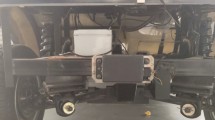Abstract
The topic of automation can be found in almost every area these days. In Industry 4.0 in particular, the exclusion of hazards to people, for example in a human-robot collaboration, is a central issue. Object tracking is an option for workspace monitoring in this context. To improve object tracking, a fusion is to be designed and implemented in this work in order to combine the various measurement properties of a Radar- and a Lidar-sensor. In this paper, the Kalman filter and the fusion in general are briefly introduced. Object tracking, the concept of the implemented fusion and the arrangement and synchronization of the sensors are then described in more detail. A final evaluation leads to the conclusion that especially the availability and the reliability in object tracking can be improved. Furthermore, it can be shown that feature-level fusion has a significant advantage over symbol-level fusion.
Access this chapter
Tax calculation will be finalised at checkout
Purchases are for personal use only
Similar content being viewed by others
References
Beyerer, J., Puente Leon, F., Sommer, K.-D.: Informationsfusion in der Mess- und Sensortechnik (Information fusion in measurement and sensor technology) Karlsruhe: Universitätsverlag (2006)
Hennes, M., Wursthorn, S.: Zur Synchronisierung von Multi-Sensor-Systemen - Grundlagen und Realisierungen (On the synchronization of multi-sensor systems - fundamentals and realizations) (2015). https://doi.org/10.13140/RG.2.1.2006.5761
Lindl, R.: Tracking von Verkehrsteilnehmern im Kontext von Multisensorsystemen: Kann die Zuverlässigkeit zukünftiger Fahrerassistenzsysteme durch eine Fusion von Laserscanner, Radar und bildgebender Sensorik gesteigert werden? (Tracking road users in the context of multisensor systems: Can the reliability of future driver assistance systems be increased by a fusion of laser scanner, radar and imaging sensor technology?) Saarbrücken: Suedwestdeutscher Verlag fuer Hochschulschriften (2010)
Liu, F.: Objektverfolgung durch Fusion von Radar- und Monokameradaten auf Merkmalsebene für zukünftige Fahrerassistenzsysteme (Object tracking by feature-level fusion of radar and monocamera data for future driver assistance systems.) Zugl.: Karlsruhe, Karlsruher Inst. für Technologie, Diss., 2009. Karlsruhe: KIT Scientific Publ. (2010)
Loffeld, O.: Estimationstheorie: Zugl.: Siegen, Univ., Habil.-Schr. u.d.T.: Loffeld, Otmar: Grundlagen, Konzepte und Anwendungen der Estimationstheorie (Estimation theory) München: Oldenbourg (1990)
Marchthaler, R., Dingler, S.: Kalman-Filter: Einführung in die Zustandsschätzung und ihre Anwendung für eingebettete Systeme (Kalman filters: introduction to state estimation and its application to embedded systems.) ser. Lehrbuch. Wiesbaden: Springer Vieweg (2017)
Ostermeier, R.: Multisensor Data Fusion in einem mobilen landtechnischen BUS-System für die Real-time Prozessführung in sensorgestützten Düngesystemen (Multisensor data fusion in a mobile agricultural BUS system for real-time process control in sensor-based fertilizer systems.) Ph.D. dissertation, TUM (2012)
Ruser, H., Puente Leon, F.: Informationsfusion - Eine Übersicht (Information Fusion - An Overview) tm - Technisches Messen, vol. 74, no. 3, p. 74 (2007)
Schwarzkopf, S.: Object Tracking in RMS320 Project (2018)
SICK AG: MRS1000, Produktfamilienübersicht (in German)
SICK AG: RMS3xx, Produktfamilienübersicht (in German)
Tränkler, H.-R., Reindl, L.M.: Signalverarbeitung bei Multisensoren: Handbuch für Praxis und Wissenschaft (Signal processing in multisensors: Handbook for practice and science), 2nd edn., ser. VDI-Buch. Springer, Heidelberg (2014)
Wittmann, D.: Erkennung und Prädiktion anderer Verkehrsteilnehmer (Recognition and prediction of other road users) Masterarbeit, TUM (2013)
Author information
Authors and Affiliations
Corresponding author
Editor information
Editors and Affiliations
Rights and permissions
Copyright information
© 2022 The Author(s), under exclusive license to Springer Nature Switzerland AG
About this paper
Cite this paper
Lindinger, M., Strand, M., Schwarzkopf, S., Honal, M., Engesser, R. (2022). Fusion of Radar- and Lidar-Data for Object-Tracking-Applications at Feature Level. In: Ang Jr, M.H., Asama, H., Lin, W., Foong, S. (eds) Intelligent Autonomous Systems 16. IAS 2021. Lecture Notes in Networks and Systems, vol 412. Springer, Cham. https://doi.org/10.1007/978-3-030-95892-3_51
Download citation
DOI: https://doi.org/10.1007/978-3-030-95892-3_51
Published:
Publisher Name: Springer, Cham
Print ISBN: 978-3-030-95891-6
Online ISBN: 978-3-030-95892-3
eBook Packages: Intelligent Technologies and RoboticsIntelligent Technologies and Robotics (R0)




